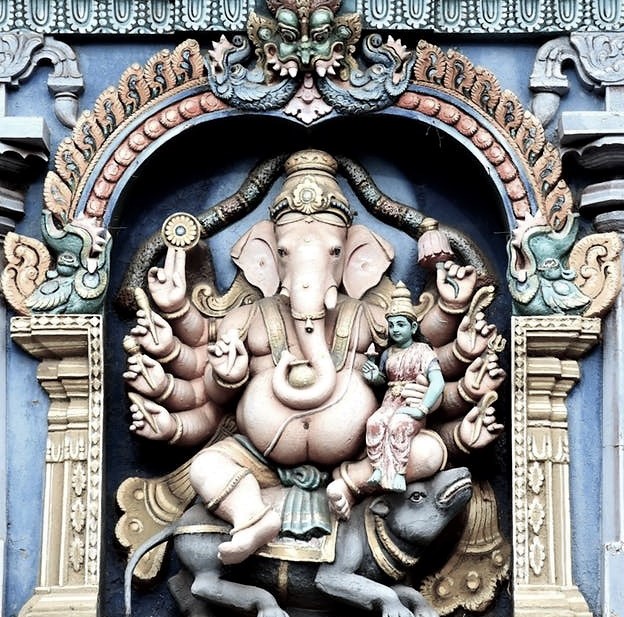- Special FeaturesFoundation YearBuilt around c. 1070 CE by the Western ChalukyasSthala TreeTheerthamRathamArchitectureOther Speciality
- Sthala Puran
The 'Tripurantaka Temple (also called Tripurantakesvara or Tripurantakeshwara) was built around c. 1070 CE by the Western Chalukyas. This temple, which is in a dilapidated state, is in the historically important town of Balligavi (also called Balagamve), modern Shivamogga district, Karnataka state, India. The exterior walls of the temple have erotic sculptures on friezes. These depictions are considered rare in Chalukyan art. Being miniature in size, these are visible only upon close examination. During medieval times, Balligavi was a seat of learning to multiple religious faiths and was home to many monuments and structures built by the Chalukyas. More than 80 medieval inscriptions have been discovered in Balligavi and belong to the Hindu (Shaiva, Vaishnava), Jain, and Buddhist traditions. These inscriptions describe, among other things, the building of temples.
The golden age of Balligavi was during the rule of the Western Chalukya Empire during the 10th-12th centuries.[2] The earliest inscription mentioning the name Balligavi is a 685 CE Badami Chalukya inscription.[2] Balligavi during these times had six mathas, three puras "extensions," five vidyapithas "places of learning," and seven Brahmapuris. The mathas belonged to Shaivas, Vaishnavas, Jainas, and Buddhists. The Kedareshwara matha belonging to the Kalamukha Shaivas and the Kodiya matha was well known and had the patronage of the Hoysala emperors, marking the place as one of religious activity. Records also indicate that an ancient University existed here.[3] The town also had 54 temples and supported 60,000 residents during that time.[2] Several Inscriptions reveal that it was a very prominent and stronghold capital of the Vira Bananju warrior merchant community, i.e., modern day Banajigara or Banajiga Balija community.
Today, Balligavi is a quiet town, much of whose daily routines revolve around agriculture and the famous 11th-century Kedaresvara Temple and Tripurantakesvara Temple.
Legend has it that Balligavi was the capital of an Asura king (demon) called Balipura (city of Bali). The Pandavas came here while on their Vanavasa (forest sojourn) and installed the Panchalinga (five linga's), hence the name Panchalingeswara to the well-known temple here. Linga is the universal symbol of Shiva.
- Architecture
This is an excellent example of a trikuta "triple towers" temple in a transitional Western Chalukya-Hoysala architecture. It is the oldest example of such a combinational style in Karnataka, according to reports from the Mysore archaeological department. The temple faces east and has a stepped entrance on three sides. The entrance on the sides is a Western Chalukya idiom. The central shrine has a linga (the universal symbol of Shiva) made from black marble (Krishnashila). The shrine to the south has a linga called Brahma, and the shrine to the north has a statue of Janardhana (Vishnu). The temple's outside plan is in "staggered-square" style with many projections and recesses, which is a Hoysala design. The outer walls of the open mandapa (hall) have carvings of women wearing fine jewellery. Two Hoysala emblems were added in 1060 CE by Vinayaditya. The superstructure (tower) of the vimana is very well decorated with sculptures of Tandaveshwara, Varaha, Uma Narasimha, Bhairava, etc. (avatars of Shiva and Vishnu), and the sukanasi of all three towers still exist. The western shrine is the oldest, dating from the 7th or 8th century. Attached to the vestibule that connects the shrines is a well designed open mantapam with two rows of pillars. The outer row of pillars are 16 faced while the inner row of pillars are lathe turned with bell shaped mouldings, a style popular with both Western Chalukys and Hoysalas. The ceiling of the mantapa is flat and the inner ceiling is well carved with lotuses in them. The central ceiling has the carving of Tandaveshwara (dancing Shiva) with eight dikpalakas (guards). The entrance to the shrine which faces east has a Nandi, the bull and a celestial attendant of Shiva.
- Alankar of Deity
- Prayers and BenefitsSpecial Vratas and PrayersOfferings to DeityStotras and Mantras
- Festivals
- Sodasha Upcharas
- Prasadhas
- Social ActivitiesAnnadhanMarriageEar BoringHead ShaveDanaasEducation FacilitiesSocial DrivesOther Activities
- Arjita Seva
- Tags

